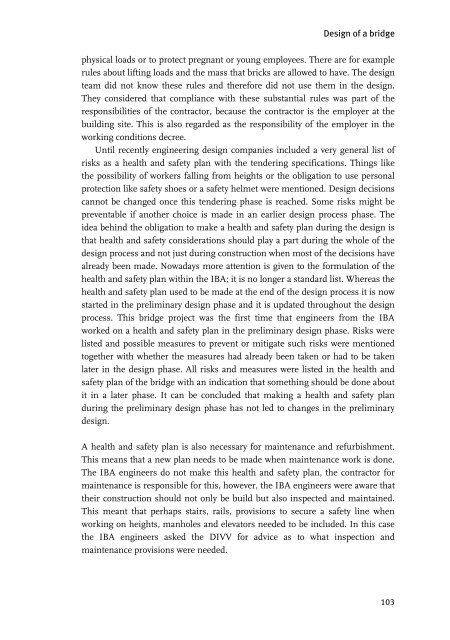Ethical issues in engineering design - 3TU.Centre for Ethics and ...
Ethical issues in engineering design - 3TU.Centre for Ethics and ...
Ethical issues in engineering design - 3TU.Centre for Ethics and ...
You also want an ePaper? Increase the reach of your titles
YUMPU automatically turns print PDFs into web optimized ePapers that Google loves.
Design of a bridge<br />
physical loads or to protect pregnant or young employees. There are <strong>for</strong> example<br />
rules about lift<strong>in</strong>g loads <strong>and</strong> the mass that bricks are allowed to have. The <strong>design</strong><br />
team did not know these rules <strong>and</strong> there<strong>for</strong>e did not use them <strong>in</strong> the <strong>design</strong>.<br />
They considered that compliance with these substantial rules was part of the<br />
responsibilities of the contractor, because the contractor is the employer at the<br />
build<strong>in</strong>g site. This is also regarded as the responsibility of the employer <strong>in</strong> the<br />
work<strong>in</strong>g conditions decree.<br />
Until recently eng<strong>in</strong>eer<strong>in</strong>g <strong>design</strong> companies <strong>in</strong>cluded a very general list of<br />
risks as a health <strong>and</strong> safety plan with the tender<strong>in</strong>g specifications. Th<strong>in</strong>gs like<br />
the possibility of workers fall<strong>in</strong>g from heights or the obligation to use personal<br />
protection like safety shoes or a safety helmet were mentioned. Design decisions<br />
cannot be changed once this tender<strong>in</strong>g phase is reached. Some risks might be<br />
preventable if another choice is made <strong>in</strong> an earlier <strong>design</strong> process phase. The<br />
idea beh<strong>in</strong>d the obligation to make a health <strong>and</strong> safety plan dur<strong>in</strong>g the <strong>design</strong> is<br />
that health <strong>and</strong> safety considerations should play a part dur<strong>in</strong>g the whole of the<br />
<strong>design</strong> process <strong>and</strong> not just dur<strong>in</strong>g construction when most of the decisions have<br />
already been made. Nowadays more attention is given to the <strong>for</strong>mulation of the<br />
health <strong>and</strong> safety plan with<strong>in</strong> the IBA; it is no longer a st<strong>and</strong>ard list. Whereas the<br />
health <strong>and</strong> safety plan used to be made at the end of the <strong>design</strong> process it is now<br />
started <strong>in</strong> the prelim<strong>in</strong>ary <strong>design</strong> phase <strong>and</strong> it is updated throughout the <strong>design</strong><br />
process. This bridge project was the first time that eng<strong>in</strong>eers from the IBA<br />
worked on a health <strong>and</strong> safety plan <strong>in</strong> the prelim<strong>in</strong>ary <strong>design</strong> phase. Risks were<br />
listed <strong>and</strong> possible measures to prevent or mitigate such risks were mentioned<br />
together with whether the measures had already been taken or had to be taken<br />
later <strong>in</strong> the <strong>design</strong> phase. All risks <strong>and</strong> measures were listed <strong>in</strong> the health <strong>and</strong><br />
safety plan of the bridge with an <strong>in</strong>dication that someth<strong>in</strong>g should be done about<br />
it <strong>in</strong> a later phase. It can be concluded that mak<strong>in</strong>g a health <strong>and</strong> safety plan<br />
dur<strong>in</strong>g the prelim<strong>in</strong>ary <strong>design</strong> phase has not led to changes <strong>in</strong> the prelim<strong>in</strong>ary<br />
<strong>design</strong>.<br />
A health <strong>and</strong> safety plan is also necessary <strong>for</strong> ma<strong>in</strong>tenance <strong>and</strong> refurbishment.<br />
This means that a new plan needs to be made when ma<strong>in</strong>tenance work is done.<br />
The IBA eng<strong>in</strong>eers do not make this health <strong>and</strong> safety plan, the contractor <strong>for</strong><br />
ma<strong>in</strong>tenance is responsible <strong>for</strong> this, however, the IBA eng<strong>in</strong>eers were aware that<br />
their construction should not only be build but also <strong>in</strong>spected <strong>and</strong> ma<strong>in</strong>ta<strong>in</strong>ed.<br />
This meant that perhaps stairs, rails, provisions to secure a safety l<strong>in</strong>e when<br />
work<strong>in</strong>g on heights, manholes <strong>and</strong> elevators needed to be <strong>in</strong>cluded. In this case<br />
the IBA eng<strong>in</strong>eers asked the DIVV <strong>for</strong> advice as to what <strong>in</strong>spection <strong>and</strong><br />
ma<strong>in</strong>tenance provisions were needed.<br />
103



